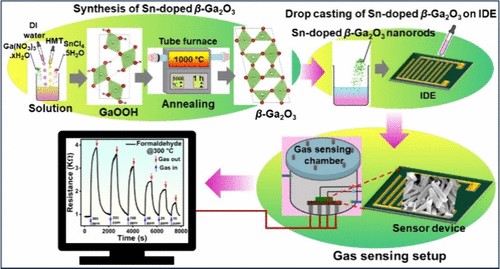
【Others Papers】Chemiresistive Sensor Based on Sn-Doped β-Ga₂O₃ Nanorods for the Selective Detection of Formaldehyde
日期:2025-02-17阅读:438
Researchers from the Indian Institute of Technology Kharagpur have published a dissertation titled "Chemiresistive Sensor Based on Sn-Doped β-Ga2O3 Nanorods for the Selective Detection of Formaldehyde" in ACS Applied Nano Materials.

Abstract
This study proposes an approach utilizing a low-cost precipitation technique to synthesize undoped and Sn-doped β-Ga2O3 materials for the detection of volatile organic compounds (VOCs), viz., isopropanol, formaldehyde, acetone, toluene, and ethanol. It is found from the field emission secondary electron spectroscopy that the nanorod-like structures are grown, while X-ray diffraction data shows that the β-phase of Ga2O3 is obtained. It was also observed that β-Ga2O3 remains monoclinic upon 5 wt % Sn doping; however, a secondary SnO2 phase is formed when the doping is increased to 5.3 wt %. Several spectroscopic techniques, such as Raman spectroscopy, X-ray photoelectron spectroscopy, ultraviolet photoelectron spectroscopy, and UV–vis–NIR spectroscopy, were used to understand the structure–property correlations. It was established that the carrier concentration in β-Ga2O3, upon Sn doping, plays a crucial role in VOC sensing, as is evident from the Hall measurements. It is established that both undoped and Sn-doped β-Ga2O3 nanorod-based chemiresistive sensor devices are highly selective to formaldehyde. A maximum response of 333.35% was achieved with 5 wt % Sn doping for the detection of formaldehyde at 300 °C with a concentration of 300 ppm, which is significantly higher than other doped and undoped samples. Interestingly, above 5 wt % Sn doping, a secondary phase of SnO2 forms a heterojunction with β-Ga2O3; thereby, an effective carrier concentration is reduced even if the dopant (Sn) concentration is high, making the response of the sensor device low. The phenomenon was explained on the basis of band diagrams and correlated with the carrier concentrations of the doped samples.
DOI:
https://doi.org/10.1021/acsanm.4c05136


